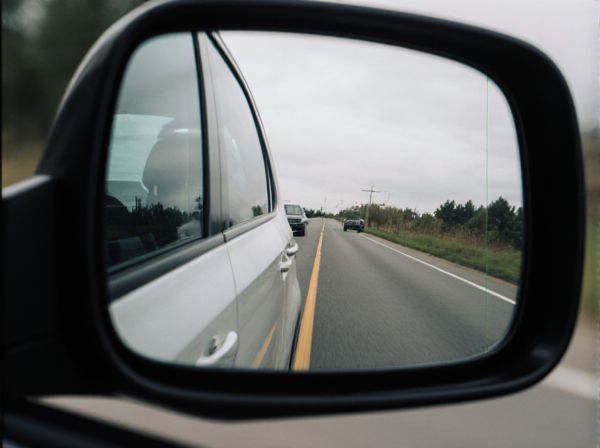
Photo illustration: Camera-Based vs Glass Mirror
Camera-based systems provide a digital view that can enhance visibility in low-light or complex environments, offering features like real-time image processing and wider field of view. Glass mirrors deliver a natural reflection with no power requirements and instant depth perception, ensuring reliable performance under all conditions. Choosing between the two depends on your preference for advanced technology versus traditional clarity and simplicity.
Table of Comparison
| Feature | Camera-Based Mirror | Glass Mirror |
|---|---|---|
| Visibility | Wide dynamic range, clear in low light | Limited by lighting, glare prone |
| Field of View | Up to 180deg, adjustable digitally | Fixed angle, approx. 40-50deg |
| Weather Resistance | Waterproof camera and lens covers | Can fog or freeze in bad weather |
| Design | Sleek, aerodynamic, fewer blind spots | Classic design, bulkier, fixed size |
| Maintenance | Electronic checks, occasional lens cleaning | Manual cleaning, prone to scratches |
| Cost | Higher upfront, potential savings on fuel | Lower initial cost, no tech involved |
| Safety | Enhanced with night mode, alerts | Depends on driver angle and lighting |
Introduction to Camera-Based and Glass Mirror Systems
Camera-based systems utilize digital imaging technology to capture and process visual information, offering enhanced features such as zoom, angle adjustment, and real-time image analysis. Glass mirror systems rely on reflective surfaces to provide a direct optical view, ensuring simplicity and minimal latency with no need for electronic components. Both systems serve distinct purposes in automotive and surveillance applications, balancing between digital innovation and traditional optical clarity.
Evolution of Automotive Mirror Technologies
Camera-based mirrors have significantly advanced automotive safety by offering wider fields of view and reducing blind spots compared to traditional glass mirrors, enhancing driver awareness and reaction times. The evolution from conventional glass mirrors to integrated camera systems incorporates high-definition sensors and real-time image processing for improved night vision and adverse weather performance. Automotive manufacturers increasingly adopt digital mirror systems, leveraging AI and connectivity to provide augmented reality overlays and adaptive brightness control, marking a transformative shift in vehicle design and driver assistance technologies.
How Glass Mirror Systems Work
Glass mirror systems operate by reflecting light through a partially transparent mirror, allowing users to see a display image superimposed on the reflected real-world view. These systems use a combination of reflective coating and optical layering to direct the digital content towards the viewer's eyes while maintaining a clear view of the surroundings. This approach provides real-time augmented reality experiences without the need for separate camera feeds or digital reconstruction of the environment.
Camera-Based Mirror Systems Explained
Camera-based mirror systems utilize high-resolution cameras to capture real-time images around the vehicle, displaying them on interior screens to enhance visibility and reduce blind spots. These systems improve aerodynamics by replacing traditional glass mirrors and incorporate advanced features such as night vision and adaptive brightness for safer driving conditions. Integration with driver assistance technologies like lane departure warnings further optimizes vehicle safety and awareness.
Safety Features: Glass Mirror vs Camera-Based
Camera-based systems offer enhanced safety features by providing wider fields of view, real-time video feeds, and digital overlays that improve hazard detection compared to traditional glass mirrors. Glass mirrors rely on reflection angles and limited visibility, which can create blind spots and reduce driver reaction times in critical situations. Advanced driver-assistance systems (ADAS) integrated with camera-based mirrors further enhance safety through features like object recognition, lane departure warnings, and night vision, surpassing the capabilities of conventional glass mirrors.
Visibility and Blind Spot Elimination
Camera-based systems provide enhanced visibility by offering wide-angle views and real-time video feeds, significantly reducing blind spots compared to traditional glass mirrors. These systems integrate advanced sensors and image processing to adapt to lighting conditions and display clearer surroundings, improving driver awareness and safety. Glass mirrors rely on direct reflection, which can be limited by weather conditions and restricted viewing angles, making camera-based technology superior for comprehensive blind spot elimination.
Design Impact: Aesthetics and Aerodynamics
Camera-based systems enhance vehicle aerodynamics by eliminating bulky side mirrors, reducing drag and improving fuel efficiency. Glass mirrors offer traditional aesthetics but create aerodynamic resistance, increasing noise and fuel consumption. The sleek design of camera-based technology supports modern, minimalist vehicle styling while advancing performance.
Cost Comparison: Installation and Maintenance
Camera-based systems generally have higher installation costs due to advanced technology and complex wiring requirements, whereas glass mirrors are more cost-efficient with minimal setup expenses. Maintenance for camera-based systems involves periodic software updates, sensor calibration, and potential repairs, which can increase ongoing expenses; glass mirrors require occasional cleaning and replacement only in case of damage, making their maintenance more affordable. Over time, camera-based solutions may offer superior durability and functionality, potentially offsetting higher initial and maintenance costs compared to traditional glass mirrors.
Regulatory Standards and Legal Considerations
Camera-based rearview systems and glass mirrors must comply with specific regulatory standards such as FMVSS No. 111 in the United States, which mandates field of view and performance requirements. Legal considerations include ensuring camera-based systems provide equivalent or superior visibility compared to traditional mirrors to meet safety laws and prevent liability issues. Manufacturers must also address cybersecurity measures and data privacy regulations associated with digital imaging components in camera-based setups.
Future Trends in Vehicle Mirror Technologies
Camera-based vehicle mirror technologies are rapidly advancing with higher-resolution sensors and AI-powered image processing, enhancing driver visibility and safety through real-time hazard detection. Glass mirrors maintain reliability but are being integrated with digital displays to offer hybrid solutions combining traditional reflection with augmented vision features. Future trends emphasize seamless integration of camera systems with autonomous driving platforms and smart connectivity for improved situational awareness and reduced blind spots.
 caratoz.com
caratoz.com